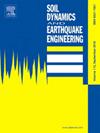Seismic fragility assessment of UHPC ribbed arch bridges
IF 4.2
2区 工程技术
Q1 ENGINEERING, GEOLOGICAL
引用次数: 0
Abstract
It is known that different types of bridge structures exhibit significant variations in the selection of ground motion IMs due to differences in their dynamic characteristics. Additionally, the dynamic characteristics of UHPC ribbed arch bridges differ from those of conventional bridge structures. Conclusions about the seismic fragility of conventional bridge structures derived from previous studies may not be applicable to this specific bridge. In this paper, seismic fragility of UHPC ribbed arch bridges is assessed through the Incremental Dynamic Analysis Method (IDA). For this purpose, an 85m UHPC ribbed arch bridge is selected as the engineering background. The 3-D finite element model of the bridge was established using OpenSees. Subsequently, 12 far-field and 12 near-field ground motion records were selected for nonlinear time-history analysis of the structure. Damage indexes for the arch ribs and tie beams were defined according to the seismic response characteristics of bridge, with the sectional curvature of five locations within these components serving as engineering demand parameters (EDPs). These EDPs were subjected to logarithmic regression analysis with respect to 8 ground motion intensity measures (IMs), aiming to evaluate the efficiency, practicability and proficiency of each IM, and to identify the optimal ground motion IM for this type of bridge. Finally, fragility curves for the arch ribs and tie beams were developed based on the fragility method, pinpointing the seismic vulnerable components of the bridge and assessing the overall seismic performance of the structure. The results indicate that the spectral acceleration at the fundamental period of the structure SAT1 is the optimal IM for fragility analysis of this bridge, followed by the effective peak acceleration EPA and acceleration-based IMs. In addition, under transverse ground motion excitations, the most vulnerable component of the bridge is found to be the E-type tie beam, followed by the springing position of the exterior arch rib. Within the given range of ground motion intensity, the bridge damage will be concentrated on non-structural components (tie beams and bridge deck). The results can provide the guidance for the seismic vulnerability assessment of UHPC ribbed arch bridges.
求助全文
约1分钟内获得全文
求助全文
来源期刊

Soil Dynamics and Earthquake Engineering
工程技术-地球科学综合
CiteScore
7.50
自引率
15.00%
发文量
446
审稿时长
8 months
期刊介绍:
The journal aims to encourage and enhance the role of mechanics and other disciplines as they relate to earthquake engineering by providing opportunities for the publication of the work of applied mathematicians, engineers and other applied scientists involved in solving problems closely related to the field of earthquake engineering and geotechnical earthquake engineering.
Emphasis is placed on new concepts and techniques, but case histories will also be published if they enhance the presentation and understanding of new technical concepts.
 求助内容:
求助内容: 应助结果提醒方式:
应助结果提醒方式:


